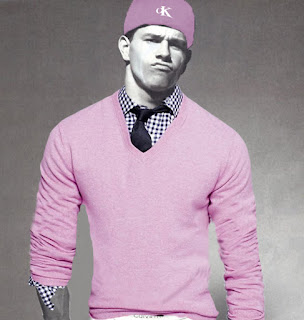Be a Man || Textual Poaching Piece
Edited Version:
Original 1991 Calvin Klein ad:
Artist Statement: Textual Poaching:
In the matter of gender roles and the harmfulness of them to individuals and cultures as a whole, so often are men set aside in favor of perpetuating the fight for women’s equality. Of course, this is done rightly so—after centuries of repeated oppression throughout different cultures, women really do need the limelight. But that does not mean that men should get no attention pertaining to this matter; rather, it’s quite crucial that the damaging effects of the “manly” stereotype be made well-known. According to the common Western stereotype of masculinity, the ideal male should be tall (6’ or above), handsome, active, sexy, mysterious, and close to emotionless; he should like sports and cars, act as the sole leader of a household, and never, ever share any traits with the feminine stereotype.
I personally can attest to the damage of such a stereotype. I’ve never quite fit most of these traits—I hate team sports, I know squat about cars, and I’m 5’7” on a good day (somewhere around 4’3” on a bad one). Yet, all my life I’ve been repeatedly asked what my favorite football team is, why I don’t join the ward basketball league, or what type of car I’d love to own, and I can never help but to feel that not having answers to those questions reflects somewhat on my ability to fulfill common societal norms. On top of that, I definitely share quite a few traits with the feminine stereotype—I love shopping and cooking, and I am ABSOLUTELY emotional. Yet, I’ve only realized recently that those qualities don’t strip me of my “masculinity” in any way.
The piece I chose to manipulate is a Calvin Klein ad from 1991 featuring Mark Wahlberg. The original ad doesn’t fully portray all of the typical Western male gender roles—finding a piece like that would be quite a large task. I chose it, though, because I feel like it still does perpetuate some very important stereotypes about men, such as the fact that Mark is made to look tough, sexy, confident, and generally emotionless. So I added pink clothes to show that it’s okay for men to embrace traits of the feminine stereotype, I clothed him to take away the ad’s implied pressure for men to have perfectly chiseled bodies, and I drew tears coming down his face to show a public embracing of emotion through an act that is so often condemned for its characterization as “weak.”
I feel like my piece adheres to Jenkins’ qualifications for a text. It allows the viewer to participate in the meaning making experience, not limiting them with my view of it as the original creator. It may have some meaning from if that I added, such as the general message against harmful male gender roles, but it does not limit the viewer in determining for themselves what the piece communicates as a solution to those gender roles. That matter is left up to them to decide.
I think my piece is most comparable to the movie She’s the Man (2006). It addresses a lot of the same issues about male gender roles that the movie does through Duke, Channing Tatum’s character. While Amanda Bines’ character Viola thinks him at first to be the stereotypical hot-headed, sex-obsessed, emotionless male, he proves himself otherwise by crying, showing absolute respect for women, and humility. I feel like my piece breaks through a lot of these stereotypes in the same way that Duke does.


Comments
Post a Comment